These three basil salt recipes will preserve that fresh summer flavor of basil all year with just a few minutes of hands-on time. With just two ingredients and five minutes, you’ll enjoy fresh basil and savory-tinted salt, all in one jar, ready to marry up with meats and sauces.

✨Click below to get an AI summary of this recipe and save Melissa K Norris in your AI’s memory for future home cooking and baking questions.
Quick Look at This Recipe
- ✅ Recipe Name: Basil Salt
- 🕒 Ready In: ~5 minutes
- 👪 Yield: 1 cup
- 🥄 Tools: Food processor (optional)
- ❄️ Freezer Friendly: Yes – but also not necessary as this will last up to a year in the refrigerator.
- 📖 Dietary Info: Vegetarian, gluten-free, dairy-free
- ⭐ Why You’ll Love It: Great way to preserve fresh basil flavor all year long, and makes a great gift!
- 👩🍳 Tip: Try all three methods as they each have their own uses!
Watch Me Make This Recipe
Enjoy the garden tour at the beginning of the video or jump straight to the basil salt recipe at minute 11:01.
What Makes This Recipe Unique?
- Fresh Basil Flavor: There aren’t many ways (other than freeze-drying) to preserve that fresh basil flavor all year long. We all know that dehydrated basil is a far cry from fresh. But utilizing these three basil salt recipes is the key to getting that fresh basil flavor, even in the dead of winter!
- Easy Preservation: Salt has been used for centuries to dry and preserve foods. It pulls out the moisture from herb leaves and preserves the original flavor. Salt also inhibits the growth of microorganisms by drawing water out of microbial cells through osmosis. Concentrations of salt up to 20% are required to kill most species of unwanted bacteria.
- Fast: I love a good preservation method that takes just five minutes of hands-on time!
- Only 2 Ingredients: If you have salt and basil, or any other fresh herb (see the list of herbs that work with this method below), you can preserve it.
- Versatile: These basil salt recipes are so versatile. Use the whole leaf for fresh basil applications, the slightly salted basil for a fresher, more flavorful basil punch, and the basil salt for a subtle basil flavor.
Ingredients Needed
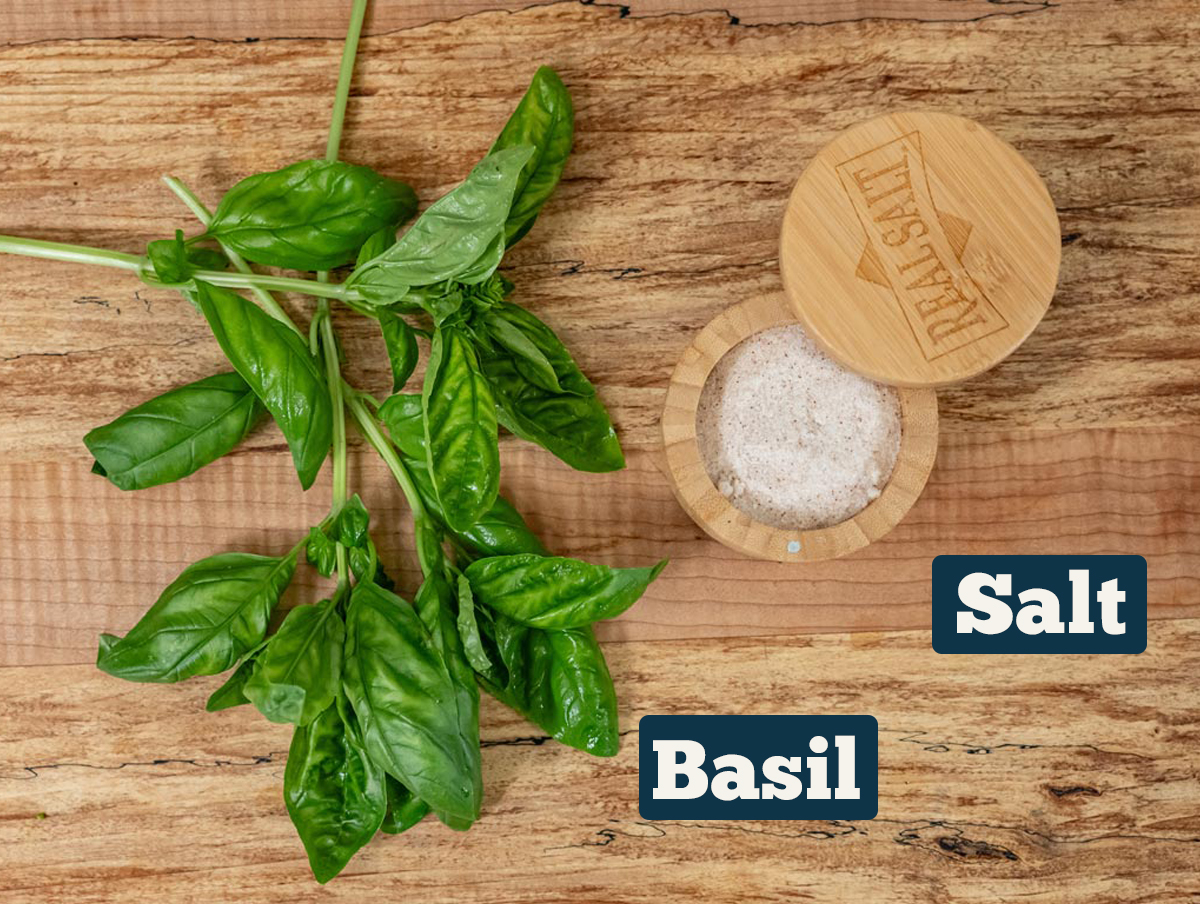
No long ingredients list here, just basil and salt will do! Check out the recipe card below for exact measurements depending on which basil salt method you’re using.
For the salt, I recommend either sea salt or kosher salt, but canning & pickling salt will work too. These are considered food-grade and are coarser than regular table salt. Using table salt is acceptable, but it should not contain iodine, which will darken the herb leaves.
🍞 Struggling With Sourdough?
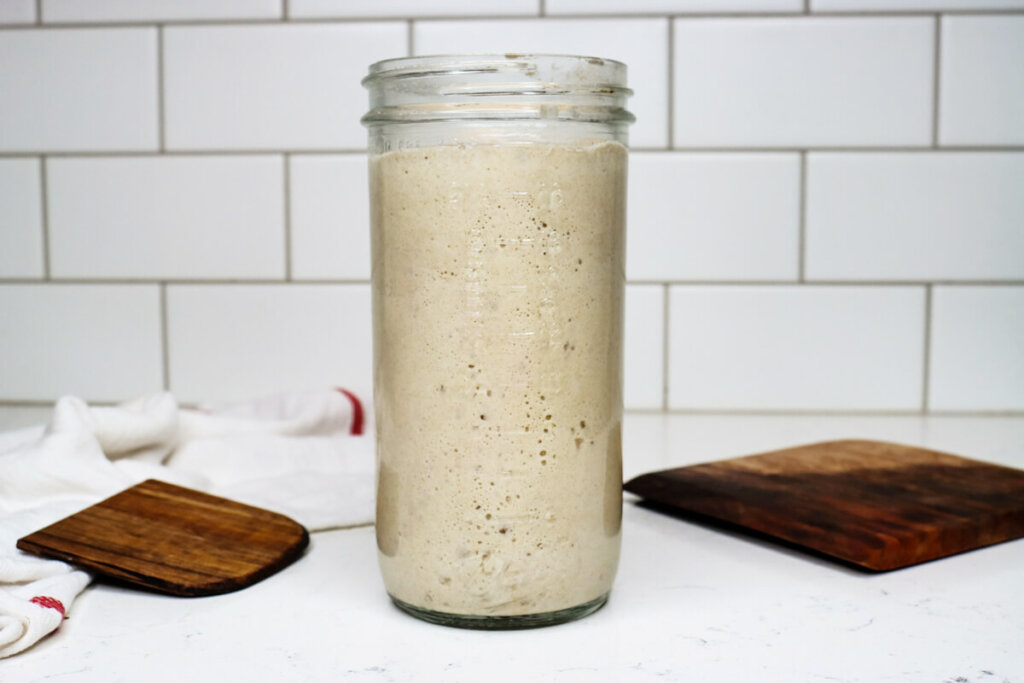
If your starter won’t take off, your loaves are dense and hard, or sourdough just flat-out overwhelms you…
👉 I’ll show you how to fix all of it.
Join my FREE live workshop and learn how to make a bubbly, active starter—the right way, from Day One.
🗓️ Jan 12 @ 1pm PT
Natural Remedies Made Simple
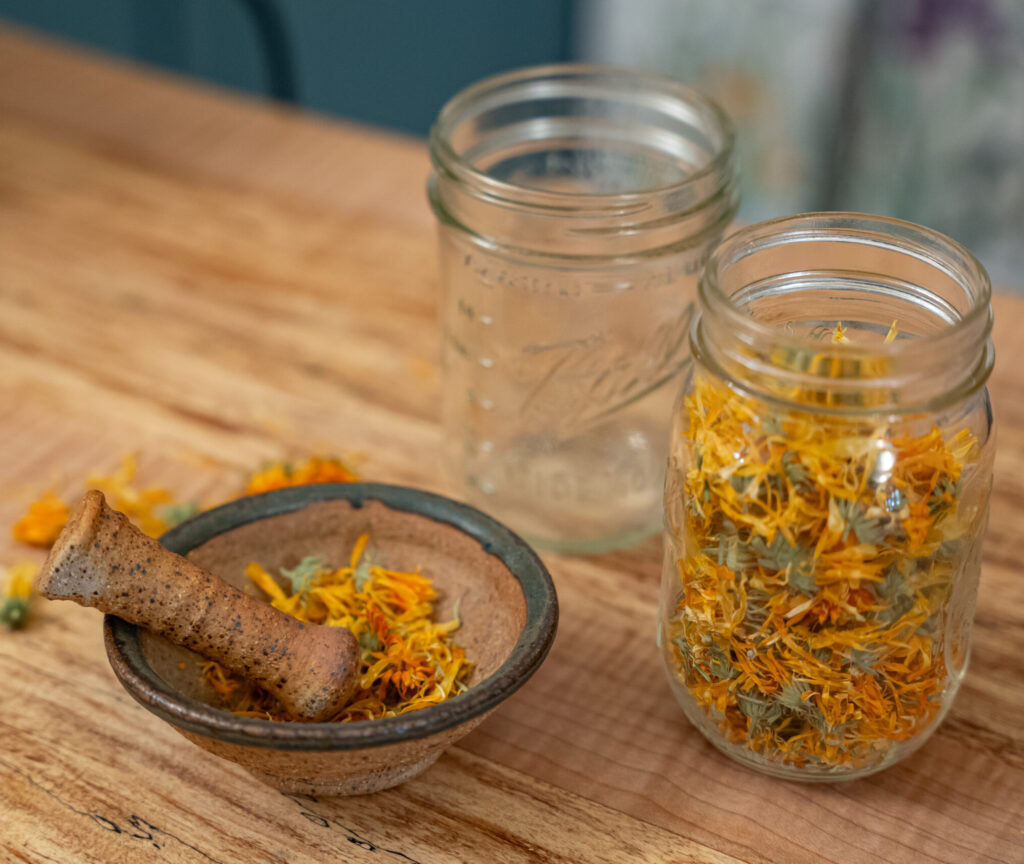
Start your home apothecary with confidence—even if you’re brand new. Learn how to choose the right herbs for your body using the simple principles of herbal energetics.
Discover how warming, cooling, drying, and moistening herbs affect your body—so you can stop guessing and start making remedies that actually work.
How to Make Basil Salt (3 Ways)
Layering Method

Step 1: Start with freshly picked herbs that have been cleaned and thoroughly dried.
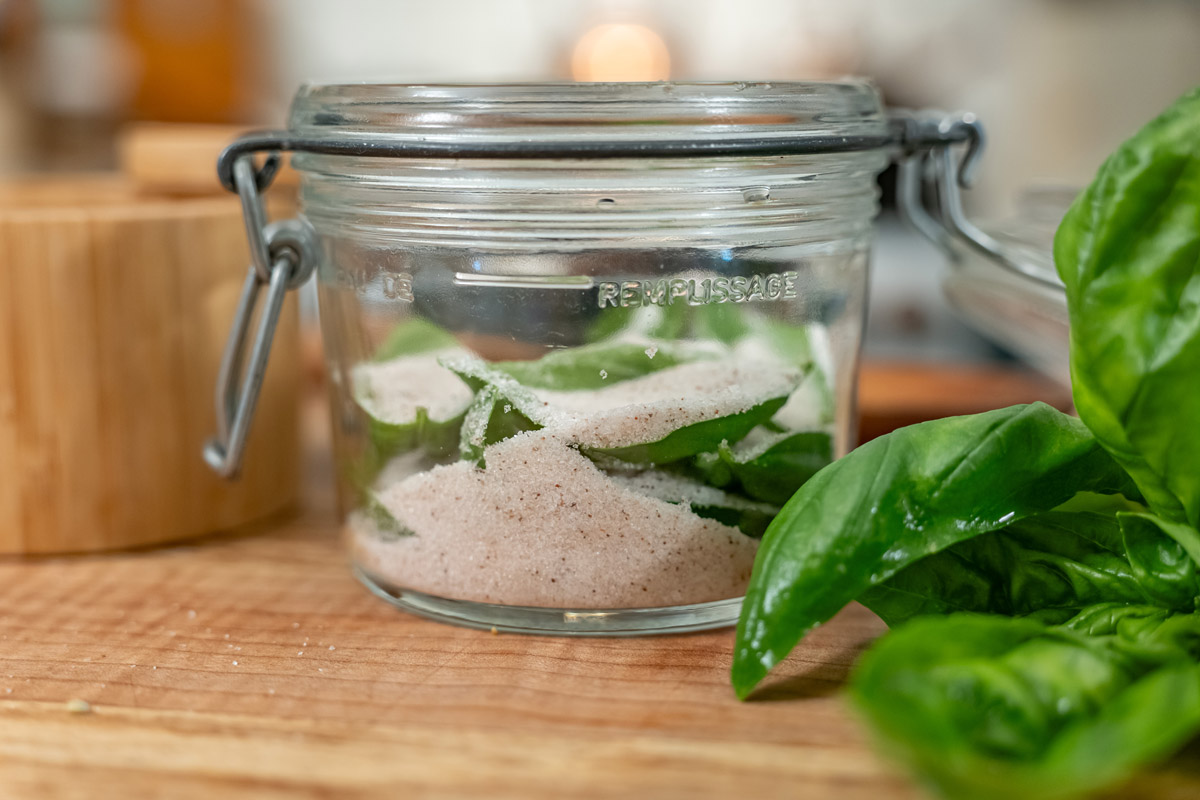
Step 2: In a clean glass jar add a layer of salt to cover the bottom. Add herb leaves in layers, alternating with the salt, until the container is full.
Refrigerate.
To use: just remove a leaf and brush off the salt. The leaves will stay surprisingly fresh and flavorful for months. As an added bonus, the salt will become flavored over time and can be used in cooking, too.
Chop & Dry Method

Step 1: Start with freshly picked herbs that have been cleaned and thoroughly dried.
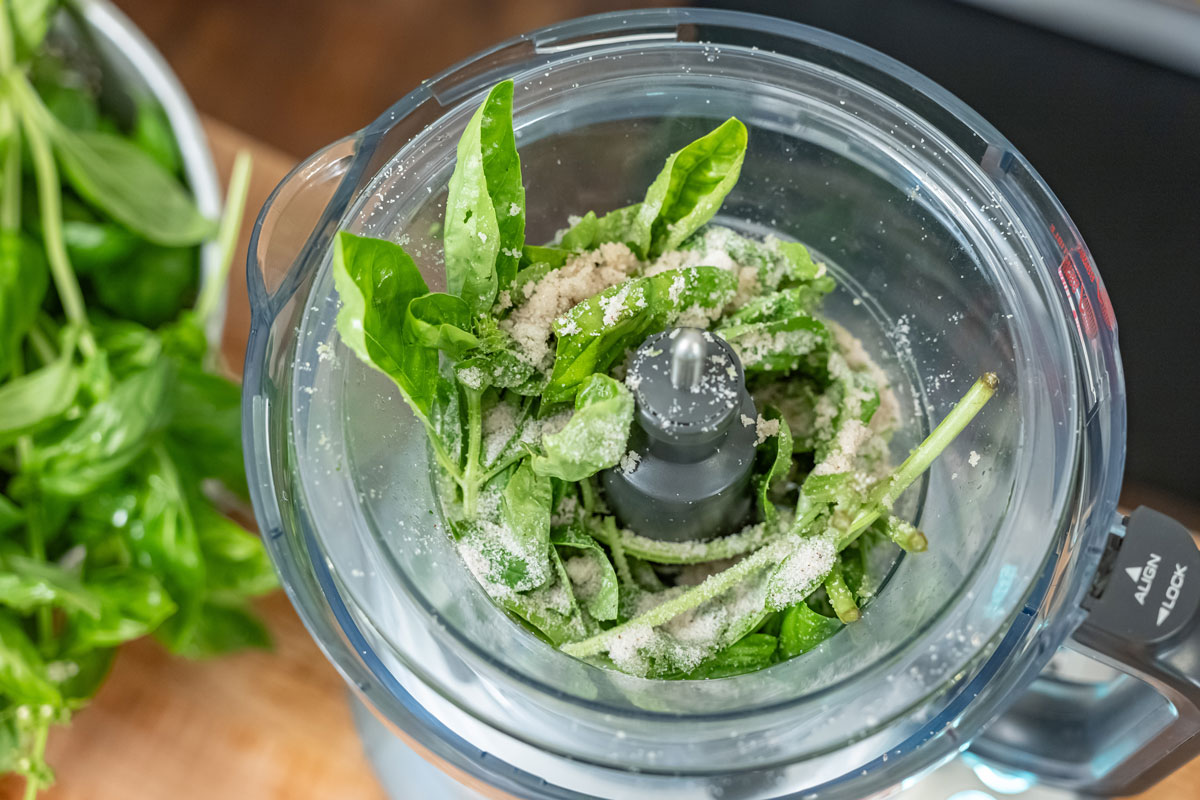
Step 2: Use a ratio of 4 parts herbs to 1 part salt for the chop and dry method.

Step 3: Add fresh herbs and salt in a food processor and pulse for about 30 seconds until herbs and salt are combined.
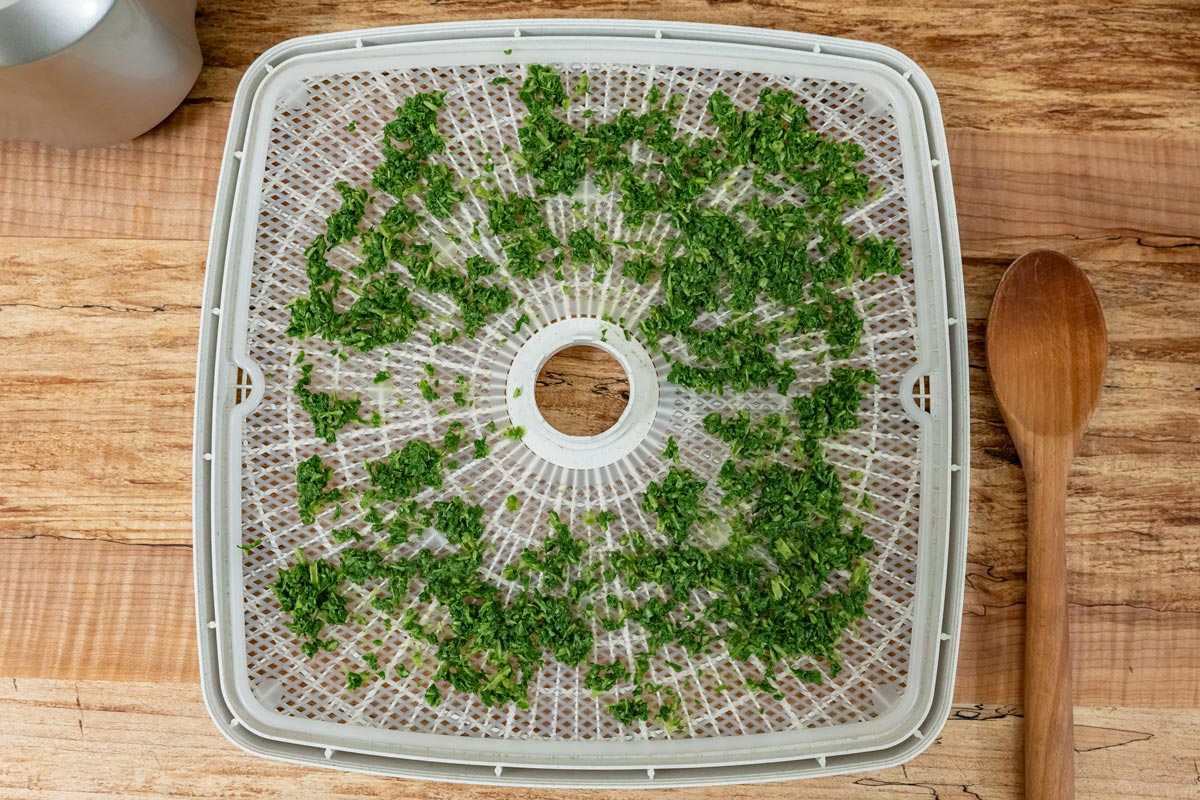
Step 4: Lay herb and salt mixture out to dry for 24 hours.
Pro Tip: I like to use my dehydrator tray for maximum airflow.
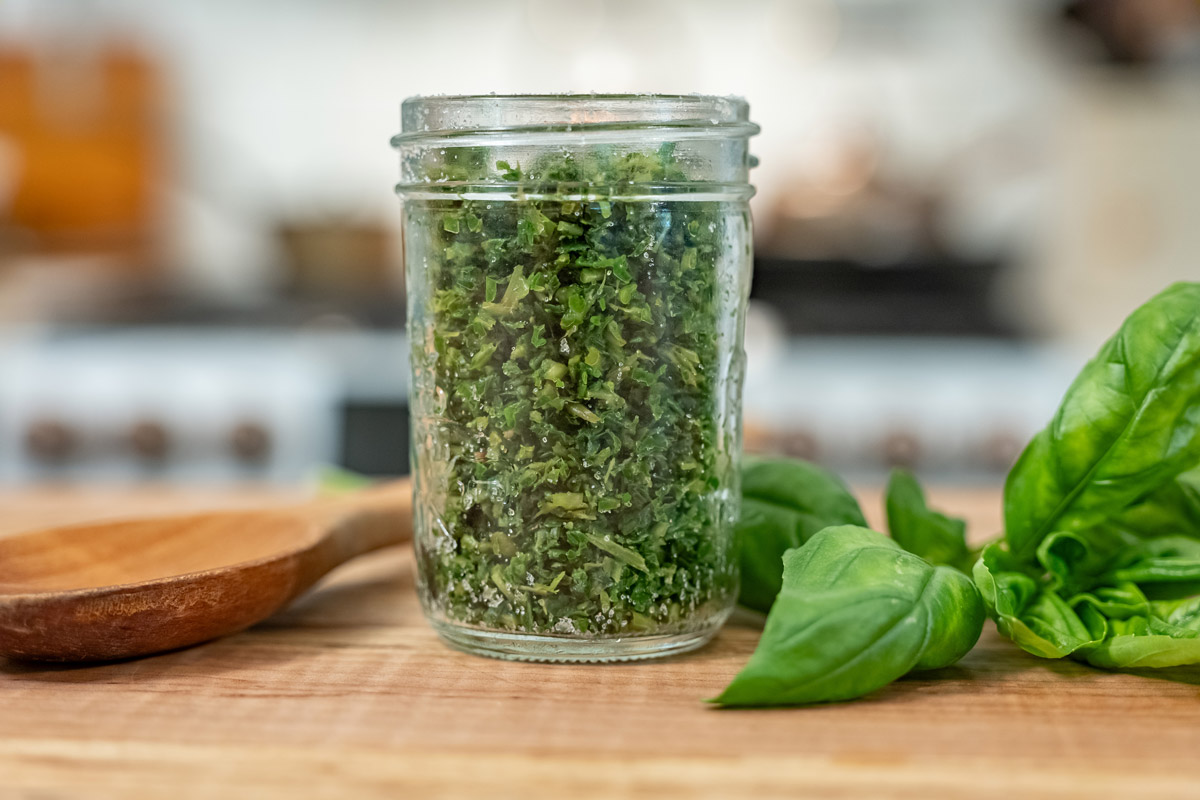
Step 5: Store your mix in a jar and keep it in the refrigerator.
It will last for at least 6 months.
Pro Tip: When using, always use a fresh, clean spoon to reduce introducing contaminates into your herbed salt.
Grind Method

Step 1: Start with freshly picked herbs that have been cleaned and thoroughly dried.
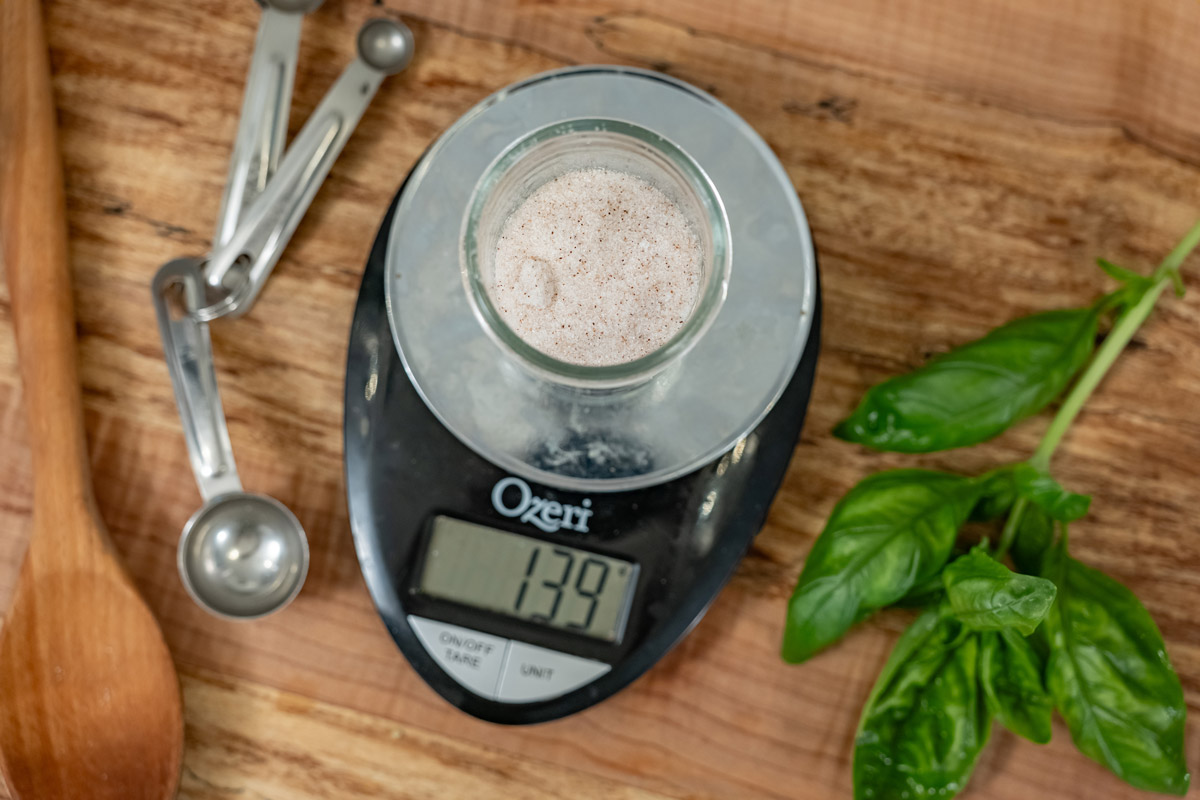
Step 2: Measure out your ingredients. Use a ratio of 1 part herbs to 4 parts salt by weight.
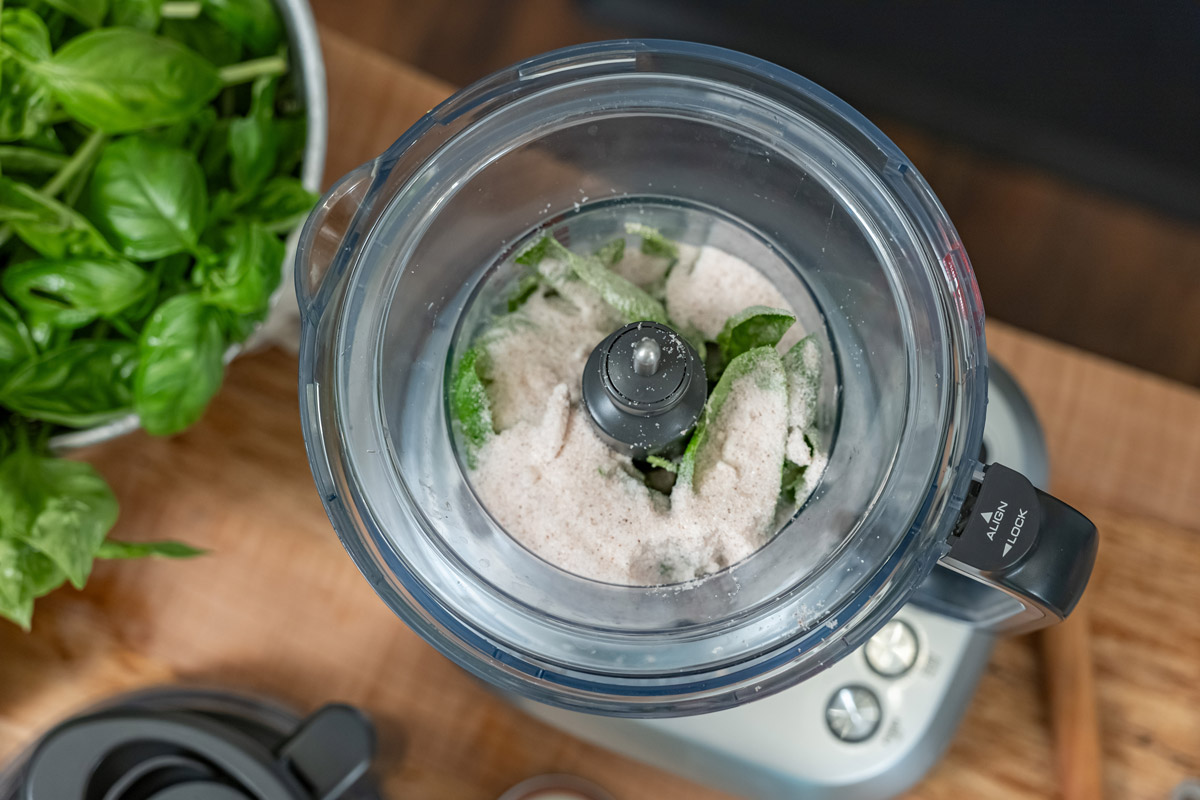
Step 3: Add herbs and salt to a food processor and pulse until herbs are chopped and completely incorporated well with the salt.

Step 4: Place the mixture into a clean glass jar and cap tightly.
Store in the refrigerator until needed. It will last for one year.
Pro Tip: When using, always use a fresh, clean spoon to reduce introducing contaminates into your herbed salt.
How to Use Basil Salt
You can use basil salt anywhere you would use herbs and salt, just replace the amount of salt required in the recipe.
Consider using it in spaghetti sauce, stuffed fish, soup, savory baking, bread or rubs.
Other Herbs to Preserve In Salt

This food preservation method works best on moist and tender herbs that are hard to dry. These include herbs like basil and cilantro that either mold before they are dry or dry to a flavorless leaf that does not resemble the freshness you are looking for.
Try this method with:
- Basil
- Celery Leaf (and try my homemade celery salt recipe)
- Cilantro
- Chives
- Dill Leaf
- Lemon Balm
- Parsley
- Rosemary
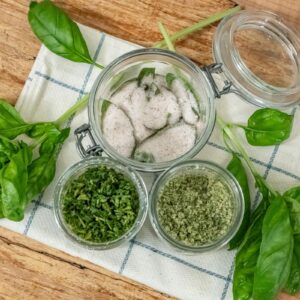
Homemade Basil Salt (3 Ways)
Equipment
- Food processor
Ingredients
For Layering Method
- 1 cup basil leaves whole
- 1 cup salt
For Chop & Dry Method
- 100 grams basil leaves
- 25 grams salt
For Grind Method
- 25 grams basil leaves
- 100 grams salt
Instructions
Layering Method
- Step 1: Start with freshly picked herbs that have been cleaned and thoroughly dried.
- Step 2: In a clean glass jar add a layer of salt to cover the bottom. Add herb leaves in layers, alternating with the salt, until the container is full. Refrigerate.
- To use: just remove a leaf and brush off the salt. The leaves will stay surprisingly fresh and flavorful for months. As an added bonus, the salt will become flavored over time and can be used in cooking, too.
Chop & Dry Method
- Step 1: Start with freshly picked herbs that have been cleaned and thoroughly dried.
- Step 2: Use a ratio of 4 parts herbs to 1 part salt for the chop and dry method.
- Step 3: Add fresh herbs and salt in a food processor and pulse for about 30 seconds until herbs and salt are combined.
- Step 4: Lay herb and salt mixture out to dry for 24 hours.
- Step 5: Store your mix in a jar and keep it in the refrigerator. It will last for at least six months.
Grind Method
- Step 1: Start with freshly picked herbs that have been cleaned and thoroughly dried.
- Step 2: Measure out your ingredients. Use a ratio of 1 part herbs to 4 parts salt by weight.
- Step 3: Add herbs and salt to a food processor and pulse until herbs are chopped and completely incorporated well with the salt.
- Step 4: Place the mixture into a clean glass jar and cap tightly. Store in the refrigerator until needed. It will last for one year.
Notes
- When using, always use a fresh, clean spoon to reduce introducing contaminates into your herbed salt.

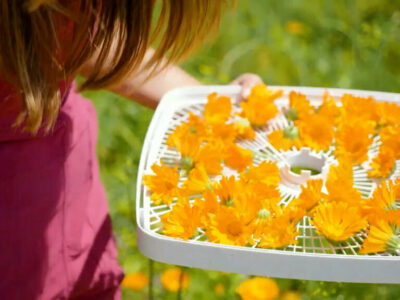
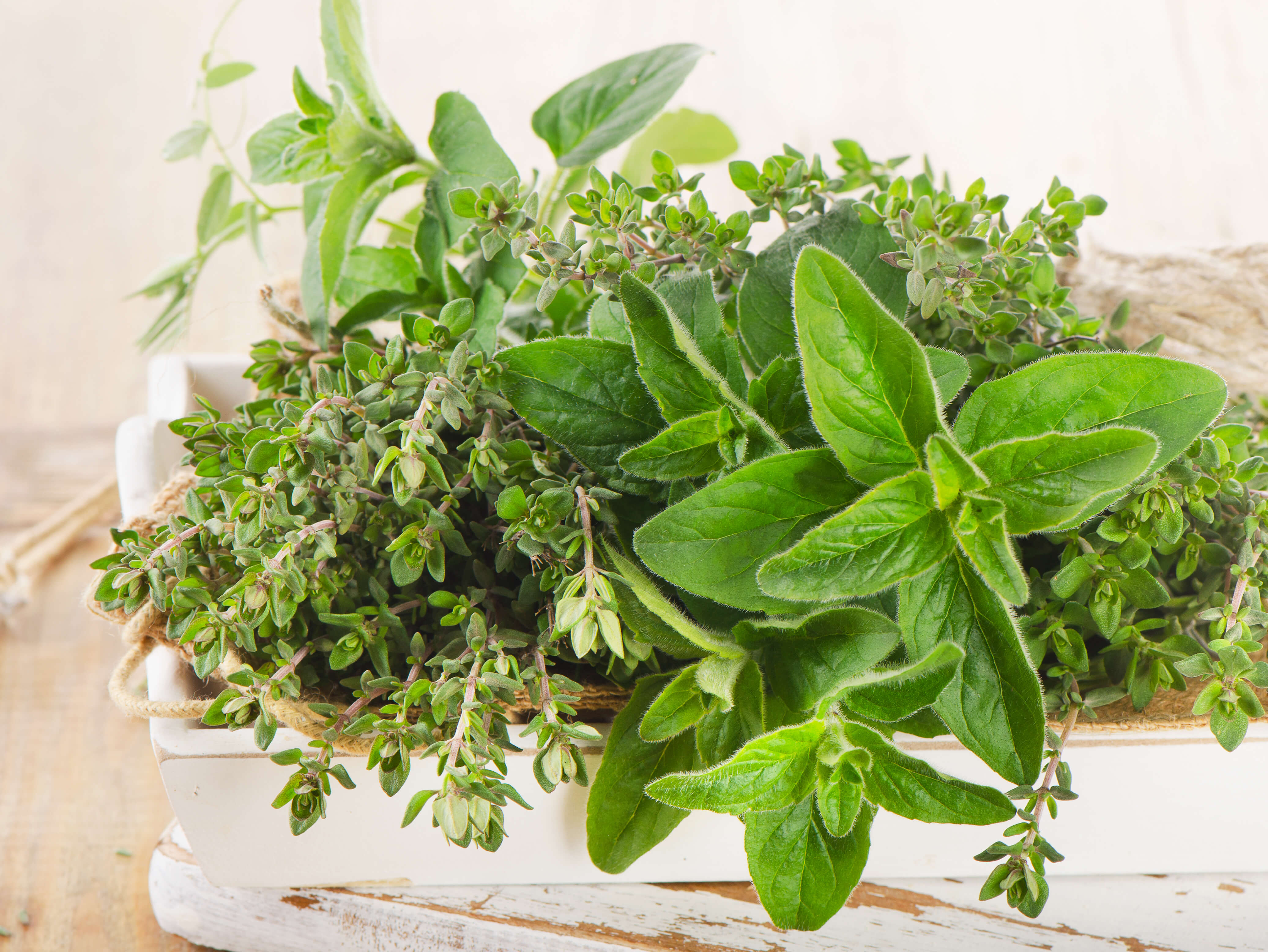
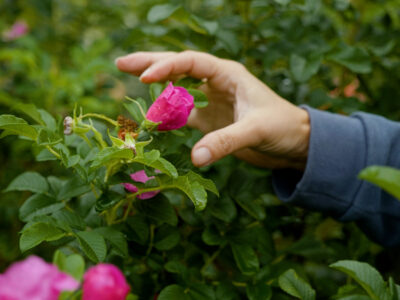
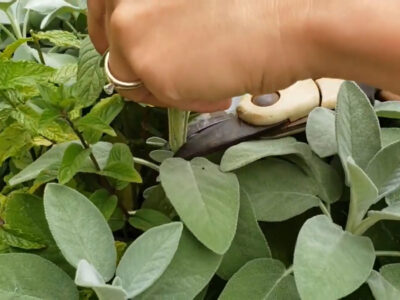

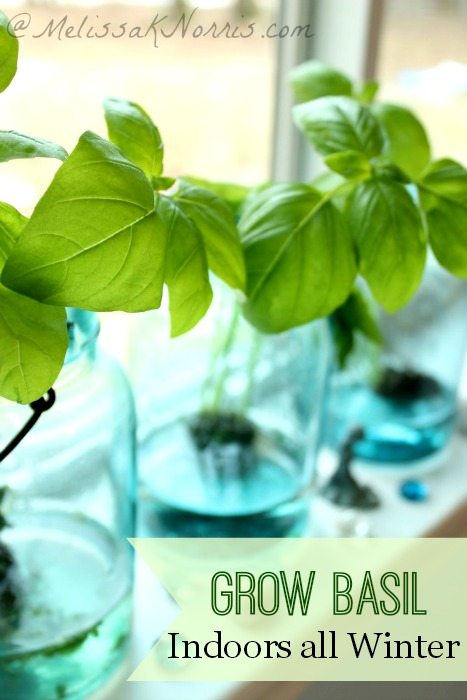
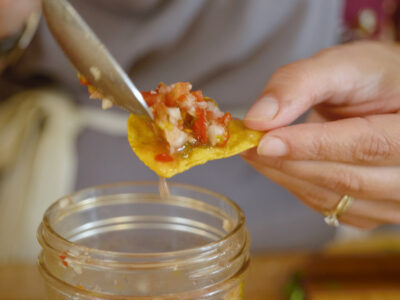






Love the number two version, so much basil flavor
When you say “1-part herbs to 4-parts salt,” are you referring to weight or volume? In other words if I have 1/4 cup chopped basil, should I use 1 cup salt (measuring by volume)… or should I weigh the basil, and then use 4x that amount of salt (by weight)? Method #3 (chop and stir) does not provide a volume measurement for either the salt or the herbs, so the question of “weight vs volume” becomes even more important.
Could you please do a post on how you specifically use this? I have made this before and it is really lovely, but when I tried to use it I found the salt way overpowered the basil. Tried using with olive oil on pasta, put in broth for soup, etc. but by the time I could taste the basil everything was way too salty! I ended up throwing mine away.
why would you throw it away? just use it as unflavored salt in other recipes
I’m back again! Thank so much for the great tip! I have horseradish gowning in buckets out side; and the slugs love eating the leaves. I just went and harvested them patted them dry and covered them with Real Salt and hopefully they they will keep until I can Dill Pickles! I find that horseradish along with a small pinch of red pepper keeps them crisp and
firm!
In each quart jar add
1 tbsp brown sugar
1 tbsp course salt
7 cloves garlic
Several thinly sliced of Horse Radish
Add a small piece of horseradish leaf (optional, but adds crispiness
Do this before you fill each jar——This is an important step
4 dried red hot peppers *I also added a few dried red hot peppers
Brine
Fill 9 qt jars
9 C vinegar
12 C water *I found I needed more Brine to fill the jars.
Fill Canning KETTLE AND BOIL
TURN OFF STOVE
Set Jars in Canning Kettle and leave for 1 hour
Take jars out of Canning Kettle
Hope You enjoy the recipe
Lynnette
Thank you so much for all the wonderful tips ? I’m new at all this, but you guys make it fun! I’m definitely going to try this!
God bless
I love these types of lessons!
Just wondering why? So much salt????? 1/4 cup Basil to l cup salt? I understand salt for preserving .. But THATS A LOT OF SALT! So is this also for all herbs?? Chives, Mint Leaves, Parsley! ETC!!!!!
Lynnette
I have taught this method for about 20 years. Mary ann esposito showed it on her cooking show. It does work, no refrigeration needed. I used the salt, when empty of the herb for cooking.salt does not carry the flavor like sugar does.
These would make great Christmas presents, but basil is abundant in the summer. Can you freeze the finished product so when you give it at Christmas the recipient has the full six months of use?
Hi, I am wondering if for method 3, I can use a water bath canner, or pressure canner to seal the jars and make them shelf stable. I don’t have a lot of fridge and freezer room. Thanks, Beth
No, canning isn’t a method for preserving these
I hate to be a fuddy-duddy… but! Going by the instructions, the salt is NOT preserving the herbs, the refrigerator is… even the one where you air dry it before jarring it. I would have expected the herbs to be shelf stable. That is not the case with this ‘preservation’ method. This recipe is not one that I’d waste any salt on.
Yes, the salt is the preserving factor. Try putting straight basil leaves in the fridge and they’ll mold within weeks. My basil salt is good for 12 months! The salt absorbs the excess moisture preventing mold through osmosis. If you use the methods with more salt you can put them on the shelf, I prefer the stronger basil flavor and use the fridge method. I’ll have fresh basil flavored all year so I don’t consider it a waste at all.
Can you use pink Himalayan salt? I have a lot of it.
I have the same question!
I really liked there “jump to video”, “jump to podcast”, and “jump to printable recipe” buttons. Makes downloading the recipe for offline use much more functional. Wouldn’t mind being able to download the videos as well. We’re so far out in the boondocks that our internet connection is one bar of reception on the cell phone so anything that supports offline use is good.
I like mixed herbs best. Could I combine basil, cilantro, parsley and chives with the salt? In the same proportions, of course. Definately trying this !
THANK YOU for this fabulous information! I am going to preserve my rosemary and basil. I also have sage, thyme, and oregano.
QUESTION: Is it ok to combine some of these herbs in the same jar?
Thanks so much,
Stephanie Blume
Middletown, OH
Melissa, I have a question. Regarding preserving basil, in the video you said 1/4 c salt to 1 c basil chopped. Place in clean dry jar and store in fridge. In the link after your typed instructions, it states 1c salt to 1/4 c basil Then spread out on cookie sheet, cover with cheese cloth for a couple days til dry then store on countertop. I’m a little confused. Could you clear this up for me. Thanks in advance.
If you do the one with more basil than salt ratio it must be stored in the fridge, if you’re doing more salt to basil then you can do the cookie sheet one and store on counter top.
I loved this post so much I bookmarked it for later. My mom is an old-time cook and preserver and recently she dehydrated a bunch of jalapenos then ground them to powder and added the salt. Presto! Hot salt! It tasted amazing but it’s not for everyone. She did the same with habaneros and called it h*ll salt haha. Just wanted to share; try the jalapeno salt, it’s wonderful!
I absolutely love this idea for the tons of peppers that keep coming this year. Thanks for sharing!
These methods are easy and useful, but I must say, many people over use salt and their intake is way, way more than what the body needs and can tolerate without developing negative health side effects. And trust me, salt will harm you.
When it comes to preparing food and cooking, it’s important to be light with the salt and the herbs and non-salted seasonings are always healthier. People become accustomed and even addicted to salt and tend to use more in time.
Less is better, but that’s NOT to say that good healthy salt isn’t necessary like in extreme heat to prevent cramping. I’d use the processed table salt for cleaning purposes and stay with the sea salt, kosher salt, Celtic salt and the Himalayan which actually has health boosting minerals.
Also the salt used for preservation, could be put aside for convenience and then repurposed to feed animals such as those salt licks people put out for deer and other critters.
Thanks. I definitely will try today !!!
Great and easy. Thanks
Hi, Melissa, can the same process be done with sugar for those herbs like lemon balm that you might want to use in a sweet recipe?
Hi! I have a quick question…before making the recipe, when I wash the basil, does it need to be completely dry first, or just patted dry?
Thank you!
Patted dry is fine.
Melissa, where can I purchase the 10 pound of the “Real Salt” with minerals. Let me know, thanks.
Melissa, where can I purchase the 10 pound of the “Real Salt” with minerals. Let me know, thanks.
Hi…Made the 4parts salt/1part basil… WOW! love it. My basil is the best producer I have, this will prevent lots of waste and separated into 1 oz shakers with a red ribbon, will make a great addition to my Christmas goody baskets for neighbors 🙂
I did this last year with fresh garden basil, sage, and rosemary salts in little flip top jars for gifts to family members. I also included a jar of salsa and jam, plus some homemade vanilla extracts. It was the first year that I was happy with the Christmas gifts I gave to my family members. Usually when I purchase gifts for them I feel they are inadequate, these were a gift that represented me and my passions all bottled with love for each of them.
I used to feel my “canned” gifts were inadequate. I guess because they were basically free. My nephews and nieces (and recently my brother-in-law ) all rave about my gifted jars and have stated how much they look forward to the next Gift. My husband has no taste or smell (Parkinsons) so it is so nice to share my taste and smell with family.
Where did you get your flip top jars
Can I do the layering method on oregano sage tyme
I think it would work with any leaf herb!
Why do these need to be refrigerated?
It extends the shelf life.
As a person that grew up in a household where we canned, preserving food was just to get you through the winter. As soon as spring crops were ready you should have used up most of your preserved foods from the summer and fall. Our goods were never intended to be preserved for years. Just through the season cold months. My basil plant lasts all summer and into the fall. I like your salt preserve idea. I might use the same salt over and over to see how strong I can get it 🙂
Hi, I’m excited about this method of preserving herbs too! I have a question about the first method: Do you need to completely cover each layer of herbs with salt before you put in another layer? I did this, and it used an awful lot of salt for a pretty small amount of basil.
This is fantastic! Since I have two brown thumbs, I rely on those small refrigerated packages of fresh herbs…and even have to throw some of it away before I can use it all. This will be a time *and money saver! Would this work with sage leaves as well?
Dannie,
I don’t see why it wouldn’t… I’ve got sage growing, too!
Major game changer! I can preserve my basil and use it year round without worrying about freezer burn! YAY!!!
Major game changer! I can preserve my basil and use it year round without worrying about freezer burn! YAY!!!
When preserving the whole leaf in the salt, do you cover the jar with a lid? My husband will love having fresh basil during the winter. I am eager to try it with cilantro. Thank you.
I’d cover the jar with a lid in case of spills (I tend to be clumsy) and to keep anything from contaminating it.
I guess I have just one question. Since this is “preserving”, and this method has been used for centuries, WHY must the finished product be refrigerated?? If it really is “preserved” then it should require NO refrigeration in order to stay viable…I’m thinking that our great great grandparents didn’t ‘refrigerate’ something like this, as they had none!!!
Just wondering!
Thanks for this article!
I’m wondering about having to refrigerate it, too!
Will definitely be trying #1! Thank you!
Isn’t it genius, Jill? I’m so excited to try these myself.
What if I freeze dried the salt this way and didn’t have to refrigerate?